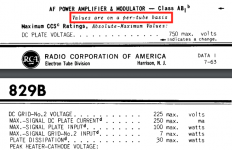I have the dumbest question ever about the power disipation of these tubes.
The 40w pd data spec is for one anode or for both combined?
Thanks.
The 40w pd data spec is for one anode or for both combined?
Thanks.
Thanks all for reply.
I take that 40w pda is for both sections together.
Still confused 40w pda 83 w output?
I beleive that gu29 can take way over the specs pda, but how much?
I take that 40w pda is for both sections together.
Still confused 40w pda 83 w output?
I beleive that gu29 can take way over the specs pda, but how much?
Those are RF Beam Power tubes.
CCS are continuous ratings. (Including Quiescent dissipation).
The other ratings are ICAS, Interrupted service; an example is CW, etc.
In an RF amplifier, the tubes can be in Class AB, B, or in Class C.
In that case, the Output Power can be more than the plate dissipation.
You could run those tubes in Push Pull Class AB, or Class B, to get more power out than the plate dissipation.
Or, you can use them as Switchers in Class D.
Class C will not work for audio.
Forced Air Cooling is recommended if you are going to run the tubes at 30W Quiescent plate dissipation (15W for each plate).
At the very least, have lots of Air between the tubes, all surroundings, and use large holes in the chassis bottom plate under the tubes, and in the chassis top plate around the tubes. Properly designed Free Air Flow, goes a long ways to preserve tube life.
Then be sure to check the glass temperature to see if it is 175 degrees C, or less.
I hope that "clears" it up for you (like when you look through that beautiful glass envelope, to those beautiful dual Beam Power sections).
CCS are continuous ratings. (Including Quiescent dissipation).
The other ratings are ICAS, Interrupted service; an example is CW, etc.
In an RF amplifier, the tubes can be in Class AB, B, or in Class C.
In that case, the Output Power can be more than the plate dissipation.
You could run those tubes in Push Pull Class AB, or Class B, to get more power out than the plate dissipation.
Or, you can use them as Switchers in Class D.
Class C will not work for audio.
Forced Air Cooling is recommended if you are going to run the tubes at 30W Quiescent plate dissipation (15W for each plate).
At the very least, have lots of Air between the tubes, all surroundings, and use large holes in the chassis bottom plate under the tubes, and in the chassis top plate around the tubes. Properly designed Free Air Flow, goes a long ways to preserve tube life.
Then be sure to check the glass temperature to see if it is 175 degrees C, or less.
I hope that "clears" it up for you (like when you look through that beautiful glass envelope, to those beautiful dual Beam Power sections).
Last edited:
Thanks for the reply.
I have two gu29 on breedboard running them in ppp mode,
with 600v b+,167v g2 and 65ma bias.Very hot.
I think to go down to 50ma, but i will redeisign the driver because the thd rises up when lowering the bias point.
I have two gu29 on breedboard running them in ppp mode,
with 600v b+,167v g2 and 65ma bias.Very hot.
I think to go down to 50ma, but i will redeisign the driver because the thd rises up when lowering the bias point.
- Home
- Amplifiers
- Tubes / Valves
- 829b/gu29 question

